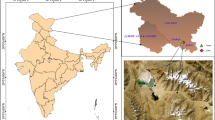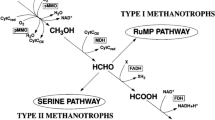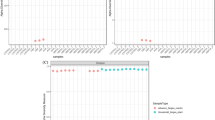Abstract
Currently, molecular biologic techniques achieve a great development in studies of soil samples. The objective of this research is to improve methods for microbial prospecting of oil and gas by applying culture-independent techniques to soil sampled from above a known oil and gas field. Firstly, the community structure of soil bacteria above the Ban 876 Gas and Oil Field was analyzed based on 16S rRNA gene clone libraries. The soil bacteria communities were consistently different along the depth; however, Chloroflexi and Gemmatimonadetes were predominant and methanotrophs were minor in both bacteria libraries (DGS1 and DGS2). Secondly, the numbers of methane-oxidizing bacteria, quantified using a culture-dependent procedure and culture-independent group-specific real-time PCR (RT-PCR), respectively, were inconsistent with a quantify variance of one or two orders of magnitude. Special emphasis was given to the counting advantages of RT-PCR based on the methanotrophic pmoA gene. Finally, the diversity and distribution of methanotrophic communities in the soil samples were analyzed by constructing clone libraries of functional gene. All 508-bp inserts in clones phylogenetically belonged to the methanotrophic pmoA gene with similarities from 83% to 100%. However, most of the similarities were below 96%. Five clone libraries of methanotrophs clearly showed that the anomalous methanotrophs (Methylosinus and Methylocystis) occupy the studied area.







Similar content being viewed by others
References
Amann RI, Ludwig W, Schleifer KH (1995) Phylogenetic identification and in situ detection of individual microbial cells without cultivation. Microbiol Rev 59(143):169
Atlas RM, Lawrence CP (1996) Handbook of microbiological medium. CRC press, New York
Baum M, Bleschert KH, Wagner M (1997) Application of surface prospecting methods in the Dutch North Sea[J]. Petroleum Geoscience 3(2):17l–181
Beghtel FW, Hitzman DO, Sundberg KR (1987) Microbial oil survey technique (MOST): evaluation of new wildcat wells in Kansas: the association of petroleum. Geochemical Explorationists Bulletin 3(1):1–14
Dehority BA, Tirabasso PA, Grifo AP (1989) Most-probable-number procedures for enumerating ruminal bacteria, including the simultaneous estimation of total and cellulolytic numbers in one medium. Appl Environ Microbiol 55:2789–2792
Dionisi HM, Harms G, Layton AC, Gregory IR, Parker J, Hawkins SA, Robinson KG, Sayler GS (2003) Power analysis for real-time PCR quantification of genes in activated sludge and analysis of the variability introduced by DNA extraction. Appl Environ Microbiol 69:6597–6604
Hanson RS, Hanson TE (1996) Methanotrophic bacteria. Microbiol Rev 60:439–471
He JZ, Shen JP, Zhang LM, Zhu YG, Zheng YM, Xu MG, Di HJ (2007) Quantitative analyses of the abundance and composition of ammonia-oxidizing bacteria and ammonia-oxidizing archaea of a Chinese upland red soil under long-term fertilization practices. Environ Microbiol 9:2364–2374
Holmes AJ, Roslev P, McDonald IR, Iversen N, Henriksen K, Murrell JC (1999) Characterization of methanotrophic bacterial populations in soils showing atmospheric methane uptake. Appl Environ Microbiol 65:3312–3318
Horz HP, Yimga MT, Liesack W (2001) Detection of methanotroph diversity on roots of submerged rice plants by molecular retrieval of pmoA, mmox, maxF, and 16S rRNA and ribosomal DNA, including pmoA-based terminal restrication fragment length polymorphism profiling. Appl Environ Microbiol 67:4177–4185
Horz HP, Rich V, Avrahami S, Bohannan BJM (2005) Methane-oxidizing bacteria in a California upland grassland soil: diversity and response to simulated global change. Appl Environ Microbiol 71:2642–2652
Hugenholtz P, Goebel BM, Pace NR (1998) Impact of cultured-independent studies on emerging phylogenetic view of bacteria diversity. J Bacteriol 180:4765–4774
Hungate RE (1969) A roll the method for cultivation of strict anaerobes. In: Methods in microbiology vol. 3. Academia Press Inc, New York, pp 117–132
Intergovernmental Panel on Climate Change (2001) The scientific basis. Contribution of Working Group I to the third assessment report of the Intergovernmental Panel on Climate Change. Cambridge University Press, Cambridge, UK
Jones VT, Matthews MD, Richers DM (2000) Light hydrocarbons in petroleum and natural gas exploration. In: Handbook of Exploration Geochemistry: Gas Geochemistry, vol. 7. Elsevier, NY, p 133
Kaster KM, Bonaunet K, Berland H, Kjeilen-Eilertsen G, Brakstad OG (2009) Characterisation of cultured-independent and –dependent microbial communities in a high-temperature offshore chalk petroleum reservoir. Antonie Van Leeuwenhoek 96:423–439
Klusman RW, Saeed MA (1996) Comparison of light hydrocarbon microseepage mechanisms. In: Schumacher D, Abrams MA (eds) Hydrocarbon migration and its near surface expression. AAPG Memoir 66:157–168
Kolb S, Knief C, Stubner S, Conrad R (2003) Quantitative detection of methanotrophs in soil by novel pmoA-targeted real-time PCR assays. Appl Environ Microbiol 69:2423–2429
Kolb S, Kenief C, Dunfield PF, Conrad R (2005) Abundance and activity of uncultured methanotrophic bacteria involved in the consumption of atmospheric methane in two forest soils. Environ Microbiol 7(8):1150–1161
Lagacé L, Pitre M, Jacques M, Roy D (2004) Identification of the bacterial community of maple sap by using amplified ribosomal DNA (rDNA) restriction analysis and rDNA sequencing. Appl Environ Microbiol 70(4):2052–2060
Li H, Yu Y, Luo W, Zeng Y, Chen B (2009) Bacterial diversity in surface sediments from the Pacific Arctic Ocean. Extremophiles 13(2):233–246
Lysnes K, Bødtker G, Torsvik T, Eva Ø, Bjørnestad ES (2009) Microbial response to reinjection of produced water in an oil reservoir. Appl Environ Microbiol 83:1143–1157
Miller SR, Strong AL, Jones KL, Ungerer MC (2009) Bar-coded pyrosequencing reveals shared bacterial community properties along the temperature gradients of two alkaline hot springs in Yellowstone National Park. Appl Environ Microbiol 75(13):4565–4572
Mogilewskii GA (1938) Microbiological investigations in connecting with gas surveying. Razvedka Nedr 8(1):59–68
Mohanty SR, Bodelier PLE, Floris V, Conrad R (2006) Differential effects of nitrogenous fertilizers on methane-consuming microbes in rice field and forest soils. Appl Environ Microbiol 72:1346–1354
Murrell JC, McDonald IR, Bourne DG (1998) Molecular methods for the study of methanotroph ecology. FEMS Microbiol Ecol 27:103–114
Muyzer G, de Waal EC, Uitterlinden AG (1993) Profiling of complex microbial populations by denaturing gradient gel electrophoresis analysis of polymerase chain reaction-amplified genes coding for 16S rRNA. Appl Environ Microbiol 59:695–700
Orphan VJ, Taylor LT, Hafenbradl D (2000) Culture-dependent and culture-independent characterization of microbial assemblages associated with high-temperature petroleum reservoirs. Appl Environ Microbiol 66(700):711
Pearson A, Rusch DB (2009) Distribution of microbial terpenoid lipid cyclases in the global ocean metagenome. ISME J 3(3):352–363
Rasheed MA, Veena Prasanna M, Satish Kumar T, Patil DJ, Dayal AM (2008) Geo-microcial prospecting method for hydrocarbon exploration in Vengannapalli Village, Cuddapah Basin, India. Curr Sci 95(3):361–366
Saunders DF, Buraon KR, Thompson CK (1999) Model for hydrocarbon microseepage and related near-surface alterations. AAPG Bull 83(1):170–185
Sealy JR (1974a) A geomicrobial method of prospecting for oil. Oil Gas J 8:142–146
Sealy JR (1974b) A geomicrobial method of prospecting for oil. Oil Gas J 15:98–102
Singleton DR, Furlong MA, Rathbun SL, Whitman WB (2001) Quantitative comparisons of 16S rRNA gene sequence libraries from environmental samples. Appl Environ Microbiol 67:4374–4376
Skovhus TL, Ramsing NB, Holmstrom C, Kjelleberg S, Dahllof I (2004) Real-time quantitative PCR for assessment of abundance of pseudoalteromonas species in marine samples. Appl Environ Microbiol 70:2373–2382
Thrasher J, Fleet AJ, Hay SJ, Hovland M, Düppenbecker S (1996) Understanding geology gas the key to using seepage in exploration: Spectrum of seepage styles. In: Schumacher D, Abrams MA (eds) Hydrocarbon migration and its near-surface expression. AAPG Memoir 66. The American Association of Petroleum Geologists, Oklahoma, pp 223–241
Wagner M, Wagner M Jr, Rasch HJ (1998) MPOG-Microbial prospection for oil and gas. Field examples and their geological background. Conference Cracov, Poland 118–121
Wagner M, Wagner M, Piske J, Smit R (2002) Case histories of microbial prospection for oil and gas. AAPG Studies in Geology 48 and SEG Geophysical References Series 11:453–479
Ward DM, Weller R, Bateson MM (1990) 16S ribosomal-RNA sequences reveal uncultured inhabitants of a well-studied thermal community. FEMS Microbiol Rev 75:105–115
Zheng Y, Zhang Li-Mei, Zheng Y-M, Di H, He Ji-Zheng (2008) Abundance and community composition of methanotrophs in a Chinese paddy soil under long-term fertilization practices. J Soils Sediments 8:406–414
Acknowledgments
This study was sponsored by the Petrotech Junior Innovation Fund of China (code: 07E1025). The authors wish to thank Qingxian Feng, a Senior Engineer of the DaGang Oil Field, for kindly providing geo-materials from the studied gas and oil field.
Author information
Authors and Affiliations
Corresponding authors
Rights and permissions
About this article
Cite this article
Zhang, F., She, Y., Zheng, Y. et al. Molecular biologic techniques applied to the microbial prospecting of oil and gas in the Ban 876 gas and oil field in China. Appl Microbiol Biotechnol 86, 1183–1194 (2010). https://doi.org/10.1007/s00253-009-2426-5
Received:
Revised:
Accepted:
Published:
Issue Date:
DOI: https://doi.org/10.1007/s00253-009-2426-5




